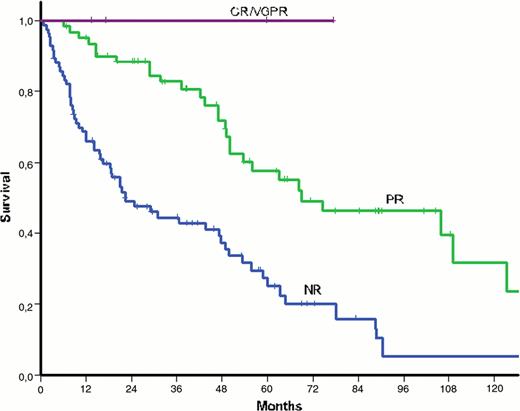Abstract
Abstract 4074
AL amyloidosis is caused deposition of monoclonal immunoglobulin light chain and is associated with IgM-paraproteinemia in 5% of cases – mostly due to underlying Waldenstrom's macroglobulinaemia. The standard treatments for AL amyloidosis are typically regimes derived from multiple myeloma and are inappropriate in this group of patients. Response to alkylating agents is poor and there is no agreed standard treatment. We describe here the treatment and outcome of 297 patients with IgM-related AL amyloidosis, with particular focus on the impact of outcomes when treated with regimes developed specifically for Waldenstrom's macroglobulinaemia.
267 consecutive IgM patients with AL amyloidosis were identified form the databases of amyloidosis groups based in London, UK, Pavia, Italy and Limonges/Tolouse/Paris, France- evaluated between 1988 and 2011. 64% of patients had underlying lymphoma mainly of lymphoplasmocytic subtype; lymph node amyloid was present in 18%. Commonest organ involved was the kidney (64%) followed by heart (42%). Serum free light chain ratio was abnormal in 163 (72%) patients with baseline difference between uninvolved and uninvolved FLC (dFLC) >50 mg/L in 124 (54%) cases. 135 patients required therapy, of whom 124 were evaluable for frontline regimen: chlorambucil/melphalan in 57, rituximab-containing regime 60 (23%) (R-CVP, FCR, RCD, R-Bortz, R-CHOP, others), purine analogs in 44 (17%), bortezomib containing 24 (8%), R-CHOP and R-CD in 18 (7%) and 20 (8%). 9 (3%) had high dose melphalan followed by autograft. The haematological response rate on an intention to treat basis was 28% (41% for evaluable patients) with only 2% VGPR or better. Median time to next treatment was 10 months with a better outcome for frontline HDM, CHOP/CVP and FCR (median 49, 16 and 13mo, respectively) with 50% responders. Median OS was 48 months. Presenting dFLC >180mg/L was predictive of poorer outcomes - median survival 48 months for patients with dFLC <180mg/L vs. 21 months for dFLC >180mg/L. The Mayo cardiac stage at presentation was strongly predictive of outcomes with median survival of stage 1 – 74 months, stage 2 24 months and stage 3 – 10 months. Although complete response rates were low, there was a significant survival advantage for patients achieving at least a partial response with estimated 3 year survival of 78% for responders vs. 55% for non-responders (figure 1).: There was a survival advantage for patients receiving HDMel, bortezomib combination (median OS not reached) and FCR (78mo) compared to (R)CHOP/CVP or FC regimens (median OS 42 and 31mo).
In summary, the overall treatment responses in patients with IgM associated AL amyloidosis are poor. Presenting free light chains and cardiac biomarkers are prognostic factors in patients with IgM associated AL amyloidosis. Patients with IgM related AL amyloidosis should be treated with appropriately tailored regimens for the underlying lymphoproliferative disorder to achieve at least PR. Exposure at some stage to bortezomib, FCR or HDM appears to be associated with better survival.
Roussel:janssen: Honoraria; celgene: Honoraria. Wechalekar:Janssen-Cilag: Honoraria.
Author notes
Asterisk with author names denotes non-ASH members.


This feature is available to Subscribers Only
Sign In or Create an Account Close Modal